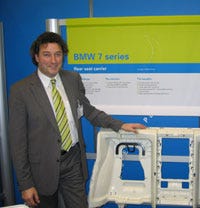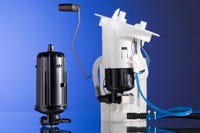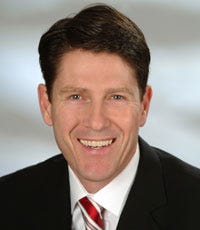Plastics in automotive design: Heavy emphasis on weight reduction
It’s not often that one theme gets repeated so frequently that it clearly is the topic de jour, but such was the case at the ‘Plastics in automobile engineering’ event in Mannheim, Germany in March.
June 4, 2009
It’s not often that one theme gets repeated so frequently that it clearly is the topic de jour, but such was the case at the ‘Plastics in automobile engineering’ event in Mannheim, Germany in March.
Most significant automotive trend? “The absolute weight of a car needs to drop. This is really high on the agenda,” said Franz Zängerl, manager for business development (automotive) at plastics supplier Borealis Group (Vienna, Austria), in a statement echoed throughout the day. In fact, lightweighting trumped the perennial “lower-the-cost” mantra.
|
Bas Blom, GM for automotive, Europe at plastics supplier Sabic Innovative Plastics (Pittsfield, MA and Bergen op Zoom, Netherlands), agreed that weight savings, and ways plastics can help OEMs reduce their fleets’ weight, is the hottest topic at present. It touches on two themes—increasing fuel economy and reducing carbon dioxide emissions—to which the industry’s OEMs long have played lip service but to which they now need to pay closer attention, as failure to do so will cost them. The Obama administration in the U.S. has made clear that the support it offers domestic carmakers is predicated largely on those companies’ promises to improve the fuel efficiency and environmental friendliness of their vehicles. Every kilogram of weight saved in a car reduces its CO2 emissions by 75 mg/km.
For European OEMs the day of reckoning is marked on the calendar, as last December the European Parliament voted to adopt a "Regulation on CO2 from cars" that will establish carbon dioxide limits and a system of fines for carmakers if their fleets don’t meet new CO2 emissions standards. The fleet average to be achieved by all cars registered in the European Union will be 130 g/km. By 2012, 65% of each manufacturer’s newly registered cars must comply on average with the legislation. This will rise to 75% in 2013, 80% in 2014, and 100% from 2015 onwards. If the average carbon dioxide emissions of an OEM’s fleet exceeds its limit value, the manufacturer has to pay an excess emissions premium, per each car registered, of €5 for the first g/km above the limit, €15 for the second g/km, €25 for the third g/km, and €95 for each subsequent g/km. This system of fines holds steady until 2019 when even the first g/km above the limit will cost €95/vehicle registered.
Reducing a vehicle’s weight is not a novel idea, nor are some of the means being considered for achieving this goal. Ralf Giesen, GM automotive business unit at Trocellen (Troisdorf, Germany), says his company is seeing resurgence in interest in a well-established technology, sandwich constructions, using his firm’s polyolefin foams as the interior material. “Right now everyone is re-discovering lightweight construction—we’re in talks with Skoda, VW, all of them,” he said, noting also that foams based on PE or PP are lower cost than polyester foams. Looking ahead, he anticipates one day seeing his foam replace rubber as the backing in floor mats (the mat stretched across the entire car interior).
The annual "Plastics in automotive design" event, organized by the VDI, the German engineers’ society, is a small but significant event on the automotive industry calendar. In years past almost 2000 representatives of Tier suppliers, OEMs, plastics suppliers, and manufacturers of machines and molds have made the trek to the event, which includes a micro-tradeshow in the foyer outside the hall where two days of presentations are made. This year the crowd was decidedly thinner but, at more than $1000/head for attendance at the conference, what else could one expect from cash-strapped carmakers and their suppliers? Besides, maybe thinner crowds make sense when weight savings is the main topic.
Material solutions spur parts’ innovation
A tour of the mini-expo colocated with the conference made clear that materials suppliers continue to aggressively develop new solutions for automotive applications. BASF (Ludwigshafen, Germany), for instance, made a splash in announcing that Bosch is molding the supplier’s Ultraform N2320 C, a carbon nanotube (CNT)-filled polyacetal (POM), into a fuel-filter housing for the Audi A4 and A5 from its facility in Budweis, Czech Republic. This is the first commercial application for this material, which, thanks to the CNTs, offers a high degree of electrical conductivity; the N2320 C material has a specific volume resistance of just 30 ohm-cm. BASF claims the material retains POM’s toughness and dimensional stability, while costing less than other conductive compounds.
Thomas Ross, marketing manager, automotive at polyolefinic foam supplier Sekisui Alveo (Lucerne, Switzerland), says the company has broken into the armrest market, replacing polyurethane (PUR) foam in passenger door armrests on the VW Tigran, with the material also now being introduced in the Golf VI, proving that a soft foam can be economical enough even for middle-class cars. The armrest has a 6-mm thick polyolefin foam pad, also replacing PUR.
Usually a relatively complicated process is needed for these parts, with PUR foamed between the carrier—in this case a press-formed natural fiber/PP—and a fabric cover. Sekisui Alveo co-developed, with a machine manufacturer, a machine and process for forming these armrests in a single step on a simple compression molding machine. Ross says feedback has been positive, especially from manufacturers of compact or midsized cars. A compact Ford (he won’t specify yet which one) will soon use it, and the next generation of the VW Sharon family van will, too.
The target market, he says, is especially those cars where to now usually hard foam is in use, a range encompassing cars from the low-end Opel Corsa to the Mercedes C-Class sedans. “The trick is we’ll have the same density but a much softer foam,” claims Ross.
Plastics supplier Borealis (Vienna, Austria) made two major introductions at this event: the world’s first air-intake manifold molded of PP (replacing PA, which itself has been replacing metal in this application for 20 years), and an injection molded rear-seat carrier of the firm’s Xmod GD302HP for the BMW 7 series sedans. Harold Hammer, VP mobility at Borealis, says the grade of PP used on the air-intake manifold, the company’s Xmod GB306SAF short-glass-fiber-reinforced PP, can be molded on tooling designed for polyamide, with minor changes to the entire process. Mahle is injection molding the manifolds for VW and reports a 15% weight savings, better acoustic behavior, and lower production costs.
On the BMW rear-seat carrier, another metal replacement scenario, circa 30% weight savings is realized. The BMW 5 series cars also will start using this carrier this year. The material is “a blend of PPs which cannot be pultruded,” a jab at long-fiber-reinforced PP materials such as Stamax that are made via pultrusion. The Borealis material has lower emissions than LGF-PP, he says.
In a move to offer better scratch resistance for interior applications than established materials such as PP, PA/ABS or ABS, Dow Automotive (Auburn Hills, MI) developed its Velvex material, a reinforced elastomer for unpainted interior trim. The supplier compounds color into the material. Dow officials at the event would offer no hints as to the identity of the elastomer used, other than to say it was one of Dow’s offerings optimized for these applications.
Gloss levels on parts molded of the material are about 1.5, comparable to painted parts. It will cost slightly more than talc-filled PP but offer significantly higher scratch resistance, Dow said. Because it is olefin-based, officials say it also offers better sound absorption qualities compared to ABS. —[email protected]
About the Author(s)
You May Also Like





